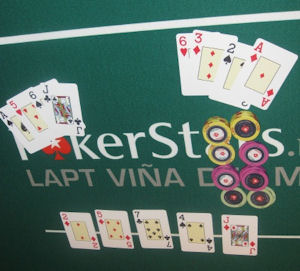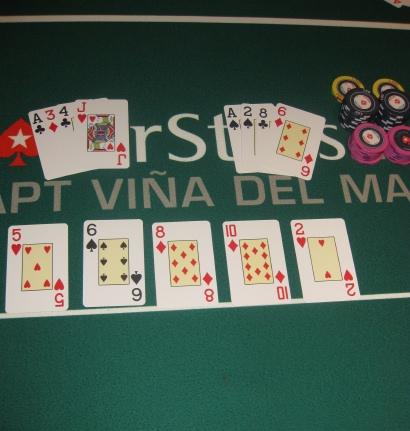Poker Strategy Articles
Poker Journal
2004-2011
Poker Journeys
Poker Player Bios
Poker Tournaments 2005-2011 Reports
My Tournament Poker Results
Heroes
Site Map
|
 Scooping
in Omaha High-Low is an extremely important concept of the game and one that should be understood completely. I am sure any regular
Omaha player (or poker player for that matter) would instantly know that scooping is much better than splitting a pot, but some of those
people don’t consider exactly how much better. For new players, learning this information could lead to a lot more money in your pocket. Scooping
in Omaha High-Low is an extremely important concept of the game and one that should be understood completely. I am sure any regular
Omaha player (or poker player for that matter) would instantly know that scooping is much better than splitting a pot, but some of those
people don’t consider exactly how much better. For new players, learning this information could lead to a lot more money in your pocket.
At first glance, it would seem that winning a $400 pot is twice as good as winning a $200 pot. I guess that statement is true in terms
of the pot, but definitely not true in terms of profit. Say the above $400 pot had 4 players who each invested $100 (not taking the
rake into consideration for the sake of simplicity); if the player scooped the pot he would actually profit $300 ($400 pot - $100 of
his own investment) and if he split the pot he would profit $100 ($200 for half the pot - $100 of his own investment). In this case,
scooping the pot and profiting $300 is three times as good as splitting the pot and profiting $100.
The difference between scooping and splitting depends
on the number of players in the pot. The more players in the pot, the less the difference is because the percentage of investment per player
is less. For example, if a pot was $1000 and there were ten players, each player’s investment would be $100, but if there were only two players,
their investments would be $500. So generally speaking, it is roughly 2.666 times as good to scoop a pot when there are five players, 3 times
as good when there are four players, 4 times as good when there are three players, to the point where it is infinitely as good when you are heads-up
with your opponent. The reverse is also true; it is infinitely worse to get scooped by your opponent. Obviously, it is plainly better to get half
of any pot than it is to get scooped, but scooping should always be on your mind.
Scooping the pot is where Omaha Hi/Low players make their money. To oversimplify, players who more or less break even on their combined
split hands and then scoop pots occasionally in between are going to be successful, profitable players. Basically, you enter pots with
scooping on your mind, but hopefully when you are unable to scoop, you are able to get half. Splitting is the thing you do to stay in
the game to give yourself opportunities to scoop.
Knowing the information is only part of understanding the concept. How you apply the information is the most important part of the equation.
When playing you should choose hands that work well together and have strong potential to scoop. Hands that are coordinated with wheel cards,
Broadway cards, and/or suited cards are ideal. The most obvious hand would be AA23 double suited (in diamonds and hearts in this example).
With this hand, you start out preflop with a pair of aces for high and nut wheel cards (the fact that you have three wheel cards is even better
because if one of the low cards gets counterfeited, you still have the nut
low draw/hand). If you are lucky enough to flop a monster like 874 with two diamonds, you can pound the pot until the cows come home. The only
way you get scooped is the rare misfortune of being double-counterfeited but there is a great chance that you will win high with the aces or hit
your flush card and scoop the pot (sometimes you might get three quarters if someone has the same low, but it is usually correct to raise in this spot).
Even if you don’t hit your flush, if you can raise out an opponent with a weak two pair to get the action heads-up, then your aces can sometimes win for high.
 Other hands with scooping
possibilities would include (but not limited to) A245, A2KK, A23Q, A2KQ, A345. If you add in suited aces to the mix, the hands become even
stronger. Note how all examples have wheel cards and some include Broadway cards. Players should stay away from hands like 2566 (despite the
fact that it contains a couple wheel cards and the hand works together). In this example, a player might be tempted to continue in a four way
pot with a flop of 654. A hand like 2566 would almost never scoop in this scenario and would most certainly cost a player money in the long run. Other hands with scooping
possibilities would include (but not limited to) A245, A2KK, A23Q, A2KQ, A345. If you add in suited aces to the mix, the hands become even
stronger. Note how all examples have wheel cards and some include Broadway cards. Players should stay away from hands like 2566 (despite the
fact that it contains a couple wheel cards and the hand works together). In this example, a player might be tempted to continue in a four way
pot with a flop of 654. A hand like 2566 would almost never scoop in this scenario and would most certainly cost a player money in the long run.
Starting hands with only Broadway cards (even without the wheel cards) can be played in most situations because they are a lot easier to get away from.
If a player holds AKQJ and the flop is 954, it is an easy fold. If the flop is 874, it is also an easy fold. It is only on flops like J74 where play
becomes more complex. The great thing about Broadway cards is when you win with full houses or a Broadway straight, you will often be scooping.
Although four Broadway cards are often easy to get away from and have scooping potential, normally they should only be played with an ace.
Scooping is an integral part of Omaha Hi/Low. If you are playing properly, you are thinking in terms of scooping. Of course there are
many times when scooping isn’t a possibility. On these occasions, take your half of the pot and move on to the next opportunity. There
are other times when you know you are going to get half, but can manipulate the hand so you can scoop (or get three quarters). Just
remember to always keep “scooping” on your mind and play hands better suited to doing so.
See also Omaha Strategy |

